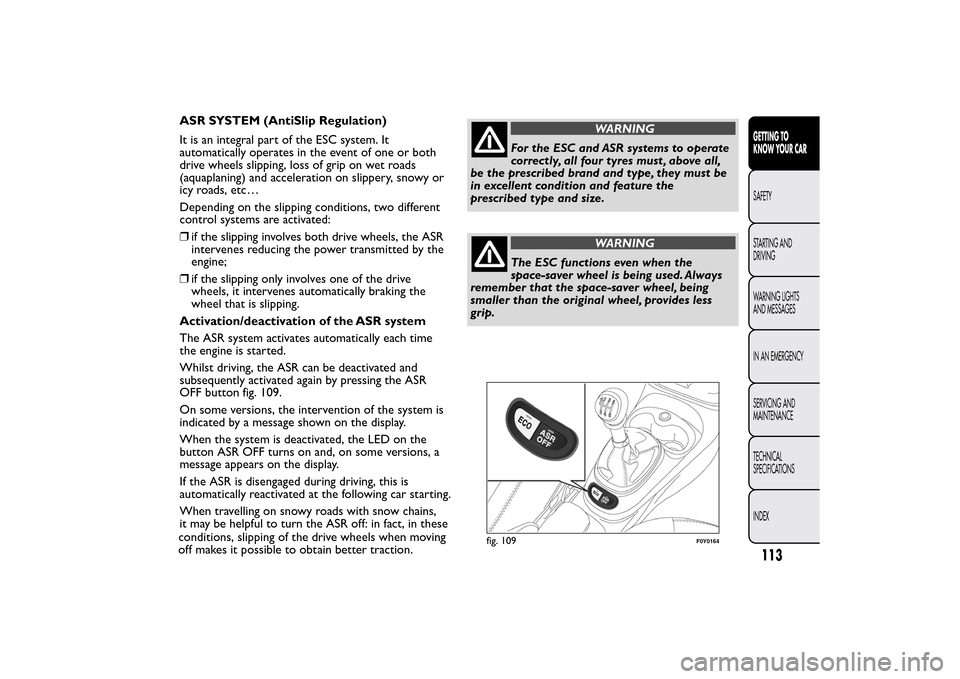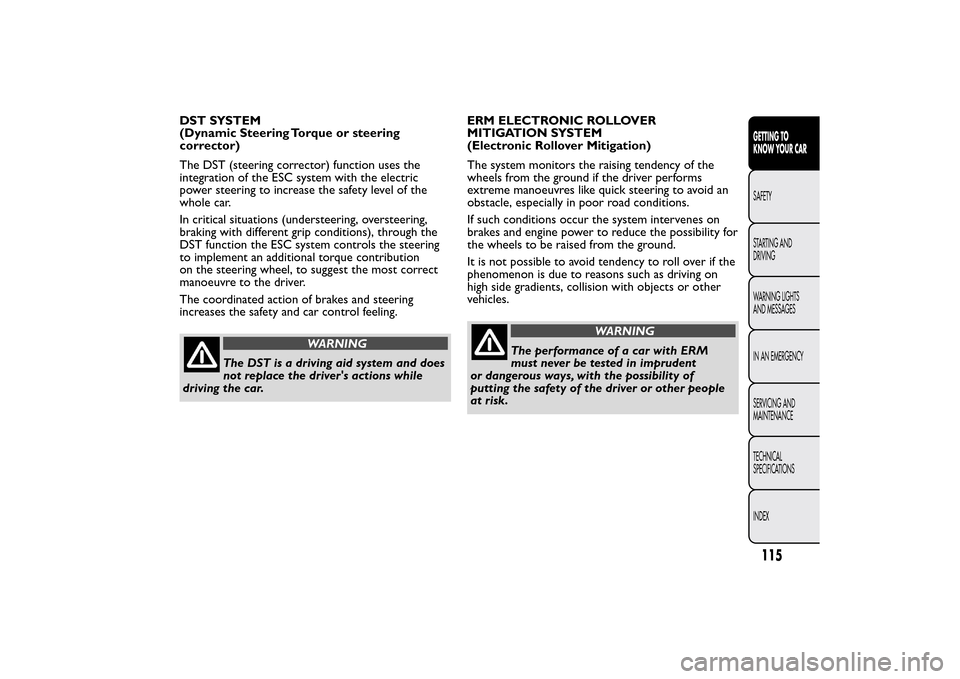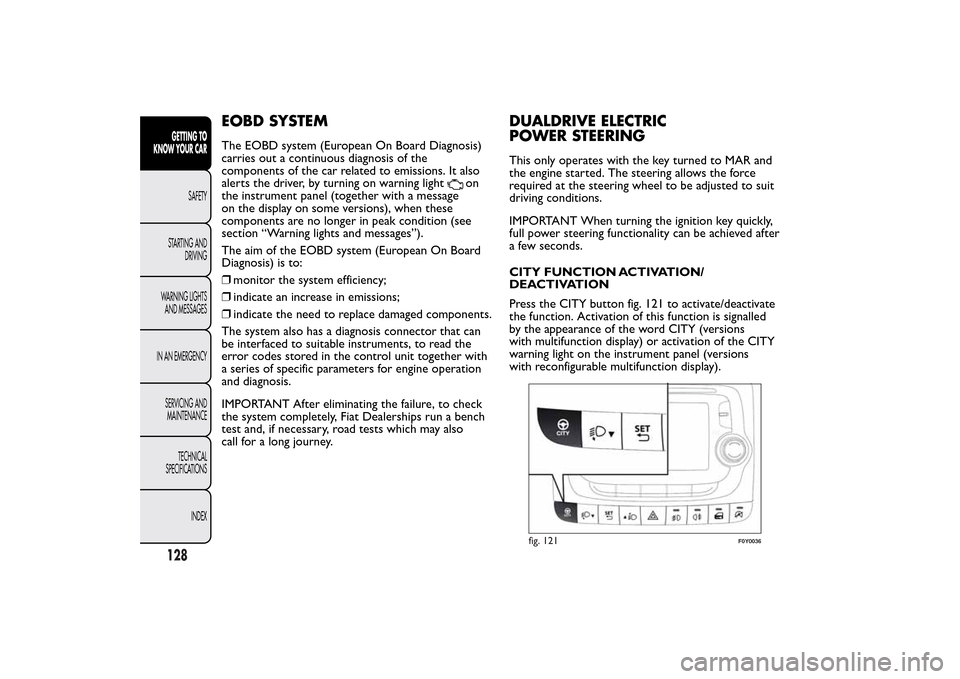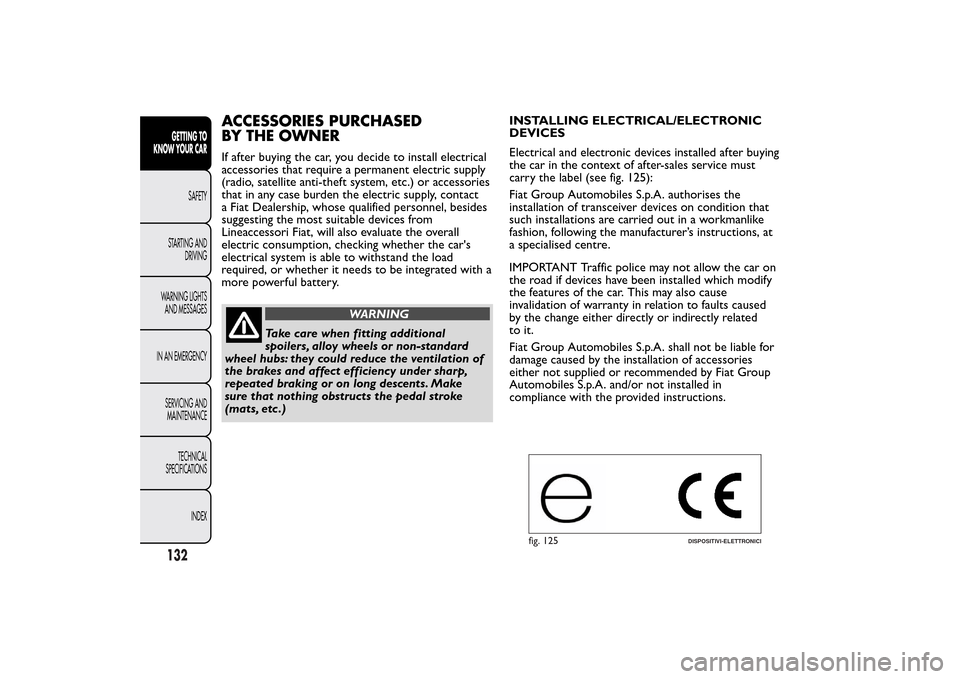2014 FIAT 500L LIVING wheel
[x] Cancel search: wheelPage 117 of 420

ASR SYSTEM (AntiSlip Regulation)
It is an integral part of the ESC system. It
automatically operates in the event of one or both
drive wheels slipping, loss of grip on wet roads
(aquaplaning) and acceleration on slippery, snowy or
icy roads, etc…
Depending on the slipping conditions, two different
control systems are activated:
❒if the slipping involves both drive wheels, the ASR
intervenes reducing the power transmitted by the
engine;
❒if the slipping only involves one of the drive
wheels, it intervenes automatically braking the
wheel that is slipping.
Activation/deactivation of the ASR system
The ASR system activates automatically each time
the engine is started.
Whilst driving, the ASR can be deactivated and
subsequently activated again by pressing the ASR
OFF button fig. 109.
On some versions, the intervention of the system is
indicated by a message shown on the display.
When the system is deactivated, the LED on the
button ASR OFF turns on and, on some versions, a
message appears on the display.
If the ASR is disengaged during driving, this is
automatically reactivated at the following car starting.
When travelling on snowy roads with snow chains,
it may be helpful to turn the ASR off: in fact, in these
conditions, slipping of the drive wheels when moving
off makes it possible to obtain better traction.
WARNING
For the ESC and ASR systems to operate
correctly, all four tyres must , above all,
be the prescribed brand and type, they must be
in excellent condition and feature the
prescribed type and size.
WARNING
The ESC functions even when the
space-saver wheel is being used. Always
remember that the space-saver wheel, being
smaller than the original wheel, provides less
grip.
fig. 109
F0Y0164
113GETTING TO
KNOW YOUR CARSAFETY
STARTING AND
DRIVING
WARNING LIGHTS
AND MESSAGES
IN AN EMERGENCY
SERVICING AND
MAINTENANCE
TECHNICAL
SPECIFICATIONS
INDEX
Page 119 of 420

DST SYSTEM
(Dynamic Steering Torque or steering
corrector)
The DST (steering corrector) function uses the
integration of the ESC system with the electric
power steering to increase the safety level of the
whole car.
In critical situations (understeering, oversteering,
braking with different grip conditions), through the
DST function the ESC system controls the steering
to implement an additional torque contribution
on the steering wheel, to suggest the most correct
manoeuvre to the driver.
The coordinated action of brakes and steering
increases the safety and car control feeling.
WARNING
The DST is a driving aid system and does
not replace the driver's actions while
driving the car.ERM ELECTRONIC ROLLOVER
MITIGATION SYSTEM
(Electronic Rollover Mitigation)
The system monitors the raising tendency of the
wheels from the ground if the driver performs
extreme manoeuvres like quick steering to avoid an
obstacle, especially in poor road conditions.
If such conditions occur the system intervenes on
brakes and engine power to reduce the possibility for
the wheels to be raised from the ground.
It is not possible to avoid tendency to roll over if the
phenomenon is due to reasons such as driving on
high side gradients, collision with objects or other
vehicles.
WARNING
The performance of a car with ERM
must never be tested in imprudent
or dangerous ways, with the possibility of
putting the safety of the driver or other people
at risk.
115GETTING TO
KNOW YOUR CARSAFETY
STARTING AND
DRIVING
WARNING LIGHTS
AND MESSAGES
IN AN EMERGENCY
SERVICING AND
MAINTENANCE
TECHNICAL
SPECIFICATIONS
INDEX
Page 120 of 420

TRACTION PLUS SYSTEM(for versions/markets, where provided)
Traction Plus is a driving aid, useful for setting off in
poor grip conditions (snow, ice, mud, etc.), which
allows the drive force to be distributed optimally on
the front axle.
The activation of the Traction Plus system generates
the differential locking effect on the front axle
through the braking system, to optimise traction on
irregular terrain.
Traction Plus acts by braking the wheels with poor
grip (or those slipping more than the others),
thereby transferring the drive force to those which
have greater grip on the ground.
OPERATION
When the engine is started the system is
deactivated.
To activate the system, press the T+ button fig. 110:
the LED on the button switches on and the display
shows a dedicated message.
The system operates at speeds below 30 km/h: when
this speed is exceeded, it deactivates automatically
(the LED on the button stays on) and reactivates
as soon as the speed drops below 30 km/h.
To deactivate the system, once activated, press the
T+ button again.Traction Plus system fault
If the system is faulty, theESCwarning light on the
instrument panel switches on constantly.
fig. 110
F0Y0248
116GETTING TO
KNOW YOUR CAR
SAFETY
STARTING AND
DRIVING
WARNING LIGHTS
AND MESSAGES
IN AN EMERGENCY
SERVICING AND
MAINTENANCE
TECHNICAL
SPECIFICATIONS
INDEX
Page 132 of 420

EOBD SYSTEMThe EOBD system (European On Board Diagnosis)
carries out a continuous diagnosis of the
components of the car related to emissions. It also
alerts the driver, by turning on warning light
on
the instrument panel (together with a message
on the display on some versions), when these
components are no longer in peak condition (see
section “Warning lights and messages”).
The aim of the EOBD system (European On Board
Diagnosis) is to:
❒monitor the system efficiency;
❒indicate an increase in emissions;
❒indicate the need to replace damaged components.
The system also has a diagnosis connector that can
be interfaced to suitable instruments, to read the
error codes stored in the control unit together with
a series of specific parameters for engine operation
and diagnosis.
IMPORTANT After eliminating the failure, to check
the system completely, Fiat Dealerships run a bench
test and, if necessary, road tests which may also
call for a long journey.
DUALDRIVE ELECTRIC
POWER STEERINGThis only operates with the key turned to MAR and
the engine started. The steering allows the force
required at the steering wheel to be adjusted to suit
driving conditions.
IMPORTANT When turning the ignition key quickly,
full power steering functionality can be achieved after
a few seconds.
CITY FUNCTION ACTIVATION/
DEACTIVATION
Press the CITY button fig. 121 to activate/deactivate
the function. Activation of this function is signalled
by the appearance of the word CITY (versions
with multifunction display) or activation of the CITY
warning light on the instrument panel (versions
with reconfigurable multifunction display).
fig. 121
F0Y0036
128GETTING TO
KNOW YOUR CAR
SAFETY
STARTING AND
DRIVING
WARNING LIGHTS
AND MESSAGES
IN AN EMERGENCY
SERVICING AND
MAINTENANCE
TECHNICAL
SPECIFICATIONS
INDEX
Page 133 of 420

When the CITY function is on, the steering wheel
effort is lighter, parking operations are easier:
therefore this function is particularly useful for
driving in city centres.
WARNING
It is absolutely forbidden to carr y out
any after-market operation involving
steering system or steering column
modifications (e.g.: installation of anti-theft
device) that could badly affect performance and
safety, invalidate warranty and also result in
non-compliance of the car with type approval
requirements.
IMPORTANT During parking manoeuvres requiring a
lot of steering, the steering may become harder;
this is normal and is due to the intervention of the
system to protect the electric steering motor from
overheating. No repair intervention is needed in this
case. When the car is used again, the power steering
will work normally again.
WARNING
Before performing any maintenance
operations, always turn off the engine
and remove the key from the ignition to lock
the steering column (especially when the car
wheels are not touching the ground). If this
is not possible (for example if the key needs to
be turned to MAR-ON or the engine must be
running), remove the main fuse that protects
the electric power steering.
129GETTING TO
KNOW YOUR CARSAFETY
STARTING AND
DRIVING
WARNING LIGHTS
AND MESSAGES
IN AN EMERGENCY
SERVICING AND
MAINTENANCE
TECHNICAL
SPECIFICATIONS
INDEX
Page 136 of 420

ACCESSORIES PURCHASED
BY THE OWNERIf after buying the car, you decide to install electrical
accessories that require a permanent electric supply
(radio, satellite anti-theft system, etc.) or accessories
that in any case burden the electric supply, contact
a Fiat Dealership, whose qualified personnel, besides
suggesting the most suitable devices from
Lineaccessori Fiat, will also evaluate the overall
electric consumption, checking whether the car's
electrical system is able to withstand the load
required, or whether it needs to be integrated with a
more powerful battery.
WARNING
Take care when fitting additional
spoilers, alloy wheels or non-standard
wheel hubs: they could reduce the ventilation of
the brakes and affect efficiency under sharp,
repeated braking or on long descents. Make
sure that nothing obstructs the pedal stroke
(mats, etc .)INSTALLING ELECTRICAL/ELECTRONIC
DEVICES
Electrical and electronic devices installed after buying
the car in the context of after-sales service must
carry the label (see fig. 125):
Fiat Group Automobiles S.p.A. authorises the
installation of transceiver devices on condition that
such installations are carried out in a workmanlike
fashion, following the manufacturer’s instructions, at
a specialised centre.
IMPORTANT Traffic police may not allow the car on
the road if devices have been installed which modify
the features of the car. This may also cause
invalidation of warranty in relation to faults caused
by the change either directly or indirectly related
to it.
Fiat Group Automobiles S.p.A. shall not be liable for
damage caused by the installation of accessories
either not supplied or recommended by Fiat Group
Automobiles S.p.A. and/or not installed in
compliance with the provided instructions.
fig. 125
DISPOSITIVI-ELETTRONICI
132GETTING TO
KNOW YOUR CAR
SAFETY
STARTING AND
DRIVING
WARNING LIGHTS
AND MESSAGES
IN AN EMERGENCY
SERVICING AND
MAINTENANCE
TECHNICAL
SPECIFICATIONS
INDEX
Page 142 of 420

Emergency refuelling
If there is no fuel in the car or the supply circuit is
completely empty, proceed as follows to reintroduce
fuel to the tank:
❒open the luggage compartment and take adapter A
located in the tool box (versions equipped with
space-saver wheel - for versions/markets, where
provided) fig. 128 or in the Fix&Go Automatic
container (versions equipped with Fix&Go
Automatic) fig. 129;
❒open the flap A fig. 127 pulling it outwards;
❒insert the adapter in the filler as shown in fig. 130
and refuel;❒after refuelling, remove the adapter and close the
flap;
❒reintroduce the adapter in the box and put this
back in the luggage compartment.
fig. 128
F0Y0230
fig. 129
F0Y0232
fig. 130
F0Y0231
138GETTING TO
KNOW YOUR CAR
SAFETY
STARTING AND
DRIVING
WARNING LIGHTS
AND MESSAGES
IN AN EMERGENCY
SERVICING AND
MAINTENANCE
TECHNICAL
SPECIFICATIONS
INDEX
Page 165 of 420

AIRBAGThe car is equipped with front airbags for driver and
passenger, driver's knee bag (for versions/markets,
where provided), seat-mounted side airbags for
driver's and passenger pelvis-chest-shoulder
protection (for versions/markets, where provided),
and window airbags for protecting the heads of front
and rear outer occupants.
The location of the airbags on the car is marked by
the writing "AIRBAG" in the middle of the steering
wheel, on the dashboard, on the side trim or on
a label placed next to the airbag deployment area.
FRONT AIRBAGS
The front driver/passenger airbags and the driver's
knee bag (for versions/markets, where provided)
protect the front seat occupants in the event of
frontal impacts of medium/high severity, by placing
the bag between the occupant and the steering
wheel or dashboard.
Therefore non-deployment in other types of impacts
(side impacts, rear shunts, roll-overs, etc.) does not
indicate a system malfunction.
Front (driver and passenger) airbags are not a
replacement for, but are complementary to, the seat
belts, which you are recommended to always wear,
as specified by law in Europe and most non-European
countries.
In the event of impact, those not wearing a seat belt
are projected forwards and may come into contactwith the bag which is still inflating. The protection
offered by the bag is compromised in these
circumstances.
Front airbags may not activate in the following
situations:
❒frontal impacts against highly deformable objects
not involving the front surface of the car (e.g.
wing collision against guard rail, etc.);
❒underride impacts with other vehicles or wedging
under protective barriers (e.g. trucks or guard
rails).
Failure to activate in the conditions described above
is due to the fact that they may not provide any
additional protection compared with seat belts, so
their activation would be inappropriate.
In these cases, non-deployment of the airbag does
not necessarily indicate a system malfunction.
WARNING
Do not apply stickers or other objects
on the steering wheel, on the dashboard
in the passenger airbag area, on roof side trims
or on the seats. Never put objects (e.g. mobile
phones) on the passenger side of the dashboard
since they could interfere with correct inflation
of the passenger airbag and also cause serious
injur y to the passengers.
161GETTING TO KNOW
YOUR CARSAFETYSTARTING AND
DRIVING
WARNING LIGHTS
AND MESSAGES
IN AN EMERGENCY
SERVICING AND
MAINTENANCE
TECHNICAL
SPECIFICATIONS
INDEX